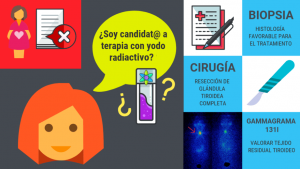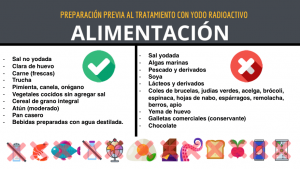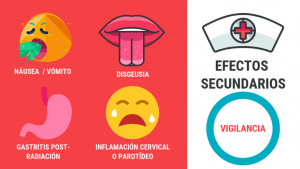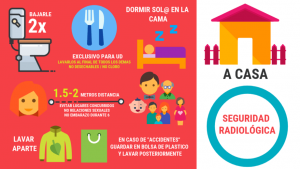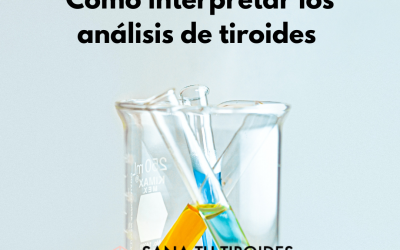By Dr. Paola Vallejo Armenta
Third-year resident of the specialty of Nuclear Medicine and Molecular Imaging at HE, CMN SXII IMSS.
Listen to the podcast episode here:https://youtu.be/4flFVTH3ubU
Radioactive iodine or radioactive iodine therapy is a nuclear medicine treatment to treat thyroid disorders such as hyperthyroidism (overfunction) or thyroid cancer. In the context of thyroid cancer, to establish whether you are a candidate for therapy, a multidisciplinary team made up of doctors specializing in nuclear medicine, endocrinology, head and neck surgery, and pathological anatomy must work as a team to establish a therapeutic approach. Initially, it is necessary to determine the type of cancer (differentiated or undifferentiated), the invasion of blood or lymphatic vessels, the type of surgery that was performed or will be performed (partial or complete), the time that has elapsed after the surgery, the extension remotely in other tissues. Always with the aim of providing the best treatment and the necessary dose.
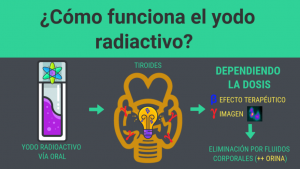 Radioactive iodine, also called iodine 131 (I-131), is an isotope (variant) of iodine that emits radiation. It is administered orally, in liquid or capsule presentation, with the aim of being absorbed at the level of the remaining thyroid cells that remained after the complete resection surgery. I-131 emits two types of radiation called gamma (ɣ) and beta (β), the first allows diagnostic images to be obtained using gamma cameras and the second is responsible for destroying the remaining thyroid cells that absorb the radioiodine. Most of the radioactive iodine that is not taken up by the thyroid gland will be eliminated during the first days after treatment, mainly through urine, but also through saliva, sweat, feces and tears, in short, through all bodily fluids.
Radioactive iodine, also called iodine 131 (I-131), is an isotope (variant) of iodine that emits radiation. It is administered orally, in liquid or capsule presentation, with the aim of being absorbed at the level of the remaining thyroid cells that remained after the complete resection surgery. I-131 emits two types of radiation called gamma (ɣ) and beta (β), the first allows diagnostic images to be obtained using gamma cameras and the second is responsible for destroying the remaining thyroid cells that absorb the radioiodine. Most of the radioactive iodine that is not taken up by the thyroid gland will be eliminated during the first days after treatment, mainly through urine, but also through saliva, sweat, feces and tears, in short, through all bodily fluids.
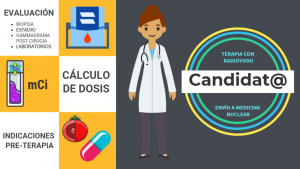 If you are a candidate to receive radioiodine therapy, the next thing is to decide the dose to receive and give the indications prior to therapy to ensure a successful result. It is important to pay close attention and resolve all doubts that may arise.
If you are a candidate to receive radioiodine therapy, the next thing is to decide the dose to receive and give the indications prior to therapy to ensure a successful result. It is important to pay close attention and resolve all doubts that may arise.
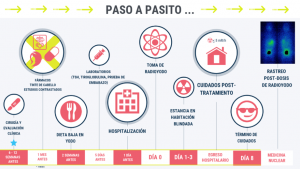 Here is a small summary: if the type of cancer you have is a candidate for receiving radioiodine therapy, the next thing to do is wait 6-12 weeks after complete gland resection surgery to be able to grant the therapy. Among the indications to follow to prepare our body for the therapy and ensure that it is successful is the suspension of drugs (levothyroxine) for 1 month, a low-iodine diet for 2 weeks, taking laboratory tests 1 week before the application of radioiodine, and subsequently internment in specialized rooms with lead shielding. Subsequently, discharge to our home after achieving optimal radiation levels to go outside and continue radiological care at home. Finally, go to the nuclear medicine service to have a total body scan to verify the sites in which the radioactive iodine that we ingested was absorbed. All these aspects can be modified based on the indications of our treating certificate.
Here is a small summary: if the type of cancer you have is a candidate for receiving radioiodine therapy, the next thing to do is wait 6-12 weeks after complete gland resection surgery to be able to grant the therapy. Among the indications to follow to prepare our body for the therapy and ensure that it is successful is the suspension of drugs (levothyroxine) for 1 month, a low-iodine diet for 2 weeks, taking laboratory tests 1 week before the application of radioiodine, and subsequently internment in specialized rooms with lead shielding. Subsequently, discharge to our home after achieving optimal radiation levels to go outside and continue radiological care at home. Finally, go to the nuclear medicine service to have a total body scan to verify the sites in which the radioactive iodine that we ingested was absorbed. All these aspects can be modified based on the indications of our treating certificate.
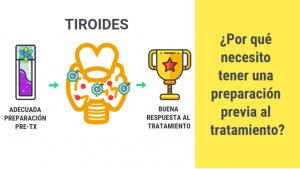 For radioactive iodine therapy to be most effective, people must have high levels of thyroid-stimulating hormone (TSH) in their blood. This hormone is what causes thyroid tissue (and cancer cells) to absorb radioactive iodine. The way to achieve this is to follow the instructions of the treating certified nuclear doctor.
For radioactive iodine therapy to be most effective, people must have high levels of thyroid-stimulating hormone (TSH) in their blood. This hormone is what causes thyroid tissue (and cancer cells) to absorb radioactive iodine. The way to achieve this is to follow the instructions of the treating certified nuclear doctor.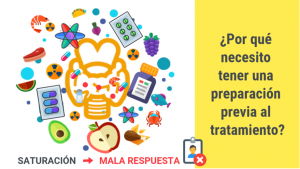 If there is not adequate adherence to the indications prior to radioiodine therapy, the receptors that are responsible for capturing iodine in the remaining thyroid cells are occupied by stable iodine obtained from the diet or medications, in this way the radioiodine that applied for therapeutic purposes will not work, it will be eliminated and there will be no therapeutic effect.
If there is not adequate adherence to the indications prior to radioiodine therapy, the receptors that are responsible for capturing iodine in the remaining thyroid cells are occupied by stable iodine obtained from the diet or medications, in this way the radioiodine that applied for therapeutic purposes will not work, it will be eliminated and there will be no therapeutic effect.
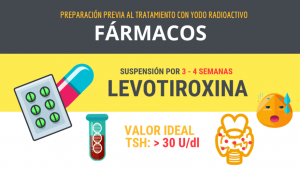 Among the most important indications that we must follow before receiving therapy with radioyo is the suspension of medications: Levothyroxine for 4 weeks or Liothyronine for 2 weeks (as the case may be). This causes temporarily very low levels of thyroid hormone (hypothyroidism) and we can experience symptoms such as tiredness, depression, weight gain, constipation, muscle aches and difficulty concentrating. It is important that despite presenting these symptoms, you DO NOT consume the medication that has been indicated to be suspended, as it would alter the result of radioiodine therapy.
Among the most important indications that we must follow before receiving therapy with radioyo is the suspension of medications: Levothyroxine for 4 weeks or Liothyronine for 2 weeks (as the case may be). This causes temporarily very low levels of thyroid hormone (hypothyroidism) and we can experience symptoms such as tiredness, depression, weight gain, constipation, muscle aches and difficulty concentrating. It is important that despite presenting these symptoms, you DO NOT consume the medication that has been indicated to be suspended, as it would alter the result of radioiodine therapy.
Another measure is a low-iodine diet for 2 weeks prior to the application of radioiodine. Here we show a list of some allowed (green) and prohibited (red) foods.
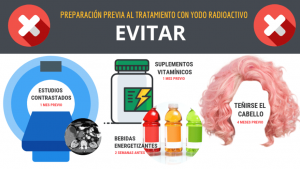 Other recommendations that must be followed prior to the application of radioiodine.
Other recommendations that must be followed prior to the application of radioiodine.
Some of the side effects after the application of radioiodine. We may feel nausea, abdominal pain due to gastritis, inflammation of the cervix or parotid glands, and distortion of the sense of taste. It is important to know that they are transitory effects. We must avoid reaching the vomit, since the radioiodine would not be absorbed and could not reach the remaining thyroid cells that we want to eliminate.
After the application of radioiodine, we will be under medical surveillance for approximately 3 days or as long as required to ensure that the amount of radiation we emit is adequate to be able to go home. Once we reach the optimal radiation levels dictated by NOM-013-NUCL-2009 for the discharge of patients who were administered radioactive material, a list of home care will be provided for the radiological safety of the patient and family. she. Such care must be carried out for at least 8 days after the application of radioiodine.
To contact Dr. Paola Vallejo, contact her at paovallejoarmenta@gmail.com
Throughout the entire process, the emotional support of the patient and adjusting their lifestyle habits permanently after receiving this treatment is very important. Our complementary program can help you:www.midetubienestar.com/salud-integral

